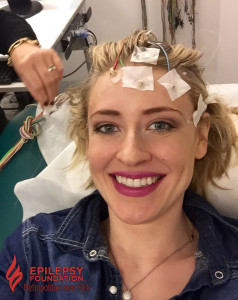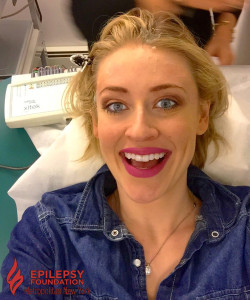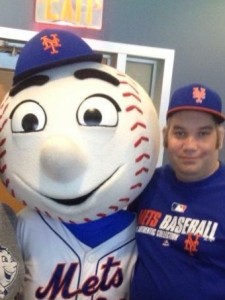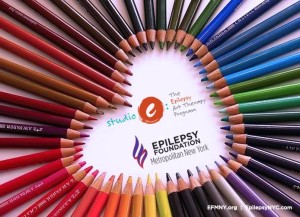I Can Spell Electroencephalogram (EEG)
Recently, my neurologist ordered an EEG test for my epilepsy. EEG stands for electroencephalogram. An EEG records the electrical activity in your brain and it helps doctors detect abnormal electrical activity of the brain. Most types of EEG tests are considered relatively painless. However, like any medical test, from scheduling to prepping for the test, an EEG can always include some inconveniences and annoyances. Anyone who has ever had to remove EEG glue from their hair, understands why I call an EEG “relatively” painless.

I had my first EEG test shortly after I was originally diagnosed with epilepsy when I was six years old. When my parents told me I had to undergo a new test related to my epilepsy, my first question was: “Are there any needles involved?” Luckily, my parents reassured me I would not be receiving a shot, getting an I.V. drip, or giving any blood. Plus, since my doctor prescribed me a sleep deprived EEG, the test prep required me to stay up late, preferably all night. Also, I got to miss a day of school, which was pretty cool! The next morning, my mother took me to my neurologist’s EEG lab. I was placed on a hospital bed and the technician glued electrodes to my head. After an hour of the technician asking me to breathe deeply and blink my eyes, they let me fall asleep. After I woke up, my electrodes were being removed from my head, and I returned home to go to bed. After several sleep deprived EEGs, I realized my mom also had to stay awake all night with me and miss work the next day. While I got to fall asleep for four hours during my EEG, my mom remained awake speaking with the technician or doctor. Now, as an adult, I understand how much an epilepsy diagnosis affects the entire family, from diagnosis to treatment.
In my twenties, I underwent a medication change because I began having a lot of seizures, again. My neurologist prescribed me several 72 hour ambulatory EEGs. For three days, I had a head full of glued-on electrodes. The electrodes were connected to wires, and the wires were connected to a small box recording the results. I could go anywhere, as long as I was still connected to my EEG box and electrodes. At work, I hid my electrode-covered head with a stylish beanie or scarf, allowing me to feel “normal.” Unfortunately, by the end of the first 48 hours, my head was itching like crazy. There was no beanie or scarf to alleviate my itchy head without removing the electrodes; but if these were to fall off, the EEG may have to be repeated! Finally, after the 72 hours, I would return to my neurologist’s office to have the electrodes removed.
After any EEG, the inevitable issue of how to remove EEG glue arises. During this period of my life, I was not connected with the Epilepsy Foundation of Metropolitan New York, so I did not know the Epilepsy Foundation’s magic trick for removing EEG glue:
· Add 5 to 7 crushed aspirin to half a cup of hot water to dissolve. Then, add 2 good size squirts of shampoo, 4 tablespoons witch hazel or seabreeze, and mix well together. Massage the mixture through wet hair and let it sit for about 15 to 20 minutes. Finally, begin to comb through your hair after an allotted time has passed. Rinse and use shampoo and conditioner as usual.
I have never had to undergo a video-telemetry EEG test, which requires a patient to spend days in a hospital wearing an ambulatory EEG box, while being recorded by a video camera. Additionally, during a video-telemetry EEG test, epilepsy medications may be reduced or withdrawn, to increase the chances that you will have a seizure that can be recorded. So, while there are rarely needles involved, I would not dare to categorize all EEGs as “painless.”
 My recent standard EEG lasted for one hour and took place at my doctor’s office. It was the easiest EEG I had ever experienced. But, like epilepsy, even the types of EEG tests can vary. Like any medical procedure, it is important to stay informed and well prepared for an EEG test. The information an EEG test provides is essential for doctors treating epilepsy. Thankfully, this past EEG was totally painless because I finally knew how to remove EEG glue from my hair!
My recent standard EEG lasted for one hour and took place at my doctor’s office. It was the easiest EEG I had ever experienced. But, like epilepsy, even the types of EEG tests can vary. Like any medical procedure, it is important to stay informed and well prepared for an EEG test. The information an EEG test provides is essential for doctors treating epilepsy. Thankfully, this past EEG was totally painless because I finally knew how to remove EEG glue from my hair!
Infantile Spasms Awareness Week
Infantile Spasms (IS), also known as West Syndrome, is a rare form of age-specific epilepsy that usually presents itself in children within the first year of life. Early diagnosis and treatment of Infantile Spasms is of the utmost importance, and in many cases can ensure a more positive prognosis and a better quality of life, and significantly increases the chances of achieving reaching normal child development milestones.
Watch the videos below and check out our blog to hear a firsthand account of what it’s like to have a child with Infantile Spasms and to learn more about how Infantile Spasms (IS) are diagnosed, what signs to look for and what treatments are available.
In honor of Infantile Spasms Awareness Week, please share the videos below with friends and family in order to help us raise awareness about this rare form of epilepsy, and about the importance of early diagnosis and treatment.
SUDEP Awareness – A Family’s Story
My brother, Jimmy, was diagnosed with epilepsy at 6 months old. He was never able to get his seizures under control, and the longest he ever went seizure free was for 6 months after he had frontal lobe epilepsy surgery in 2011. However, 6 months after the surgery, his seizures returned and progressed to the point that his disease was just as bad as it was prior to the surgery. His neurologists were just getting him cleared for another brain surgery when he passed away from SUDEP or sudden unexpected death in epilepsy.
More information needs to be made available about SUDEP for people with epilepsy and their families, and throughout the medical community. The first time anyone in our family ever heard about SUDEP was the day after Jimmy died, not once had we heard of it before then. Since my brother’s death I have talked to others with epilepsy and none of them had heard of SUDEP prior to Jimmy’s passing. In order to make informed decisions about our health, we must have all the facts.

My family and our many wonderful friends just recently participated in the 4th Annual Into The Light Walk for Epilepsy in NYC, in honor of Jimmy, to celebrate his life, and to help improve the lives of others living with epilepsy in our community. We are making efforts to tackle SUDEP and Keeping The FAITH For JIMMY. Raising SUDEP Awareness helps spread much needed information, promotes the importance of comprehensive health education and can help prevent another family from being surprised and deeply affected by something unknown, like we were. Please join us on this mission.
 After my brother died, my family and I recalled that not once in his life did Jimmy ever question why he had epilepsy. He accepted the disease and it did not ever deter him from living his life. Many times this made us crazy because we were scared for his safety, but he wanted to live freely and enjoy his life. Epilepsy never defined Jimmy, he always lived life to the fullest, and for this we are happy and grateful. My brother was a diehard Mets fan and I think we are on this big run because of him. We love you forever Jimmy.
After my brother died, my family and I recalled that not once in his life did Jimmy ever question why he had epilepsy. He accepted the disease and it did not ever deter him from living his life. Many times this made us crazy because we were scared for his safety, but he wanted to live freely and enjoy his life. Epilepsy never defined Jimmy, he always lived life to the fullest, and for this we are happy and grateful. My brother was a diehard Mets fan and I think we are on this big run because of him. We love you forever Jimmy.
Please make sure you let your family and friends know that you love them, every chance you get.
Sincerely,
Kenny Hellmann


Help spread SUDEP Awareness! For more information, please visit:
Studio E for Teens NYC – Art Therapy
The Epilepsy Foundation of Metropolitan New York is excited to announce the first ever Epilepsy NYC Studio E Art Therapy for Teens!
Made possible through the generous support of Lundbeck, Studio E offers a unique way for people with epilepsy to socialize with others and open up honestly about daily challenges in a trusting, creative environment. Art therapy promotes self-expression and builds confidence. Recent studies have shown that Studio E improves quality of life and
self-esteem.
After the great success of the Annual Studio E Program hosted by EFMNY and supported by well-received public exhibitions, Art Therapist Melissa Diaz joins us once again to provide an 8-session group program, in the same open studio model, but now tailored specifically for teenagers with epilepsy.
WHO: Teens ages 15-19
WHEN: Tuesdays after school beginning in late October 2015
(8 sessions)
WHERE: Mount Sinai Beth Israel’s PACC at Union Square
To enroll or learn more please contact Katie Lorenzo at klorenzo@efmny.org or call us at 212-677- 8550.
The program is offered at no cost to participants. You must be 15-19 years old. Seating is limited and a phone interview with the art therapist is required.
My Epilepsy Story
I recall the day I had my first seizure very well. I was walking into the room where a school-wide mass was taking place when suddenly, as the music began, I became very anxious. Everything seemed to be in slow motion – even the music slowed down and I started to shake. I did everything I could to continue standing but the pain was too great. I slowly dropped to the floor. At one point, I thought I was dying (I thought this was the end). I woke up to the comforting smiles of my middle school’s vice-principal and nurse. My body was physically drained. They told me I had a seizure.
What was a seizure? For someone who had no bad medical history, why me? The shock of the diagnosis of Epilepsy was a bit overwhelming in and of itself, but then I had to learn all about it. All of it seemed so surreal. Over the next two years I went through countless seizure-drug combinations, some of which drastically changed my mood. At one point, brain surgery was discussed.
I was already struggling with anxiety but the diagnosis only made things worse. I constantly would wonder “When would my next seizure happen?” I was terrified. Seizures didn’t just affect me physically, they affected me emotionally and socially. During Middle School, I was nervous when I wasn’t around an adult. Also, I felt other students didn’t really understand me, some were even scared to have me around. There was always a sense of guilt and that I just caused ‘extra work’ for everyone; often I just wanted to disappear.

In the 9th grade I starting to become very socially withdrawn and didn’t feel accepted. I began to spend more time composing and engineering music, whether it be in the hospital, my room or a local studio. I caught a break and started working with major songwriters and recording artists, while continuing school. Throughout high school, I only had a few people I could confide in. There aren’t a lot of people who will understand those daily struggles. Most never saw the tears or the endless nights in the hospital.
When I graduated June 2014, my seizures were finally controlled by medication. I recently started college, focusing on graphic design, while continuing on music collaborations. I consider myself extremely blessed to have had great support from family, teachers, doctors and school nurses.
My dream is to create a career in the arts, one that will help inspire other struggling artists to persevere and push beyond the seemingly hopeless circumstances they sometimes face in life.
My Life With Epilepsy
Dear EpilepsyNYC Community,
I am Kate Spratt. I am 28 years old, and I have epilepsy.
When I was six years old, I had my first seizure: on Christmas Eve, I was looking at the twinkling lights on our Christmas tree and my Grandma was talking to me but I wasn’t responding, I just kept looking at the lights.
However, I don’t remember this. All I remember is waking up in the hospital and being very confused. Worried that I was going to miss out on Christmas, I spent that night in the hospital having multiple tests and a spinal tap done. After that, for the next five years of my life, I was seizure free.
Then suddenly, when I was eleven, I had three grand-mal seizures and I was put on medication. During my pre-teen and teenage years, my seizures were under control (for the most part). I did have some “jerks,” but they didn’t affect me enough to debilitate me. I went to school, hung out with my friends, and participated in after school activities. I am grateful for that. I didn’t really talk about my epilepsy when I was a teenager, only a few of my close friends knew. Looking back, I think I didn’t tell people because I wasn’t sure how they would react.
Then, when I was around sixteen, I was in class one day, about to take a test, and I had a seizure. Next thing I knew, I was on my side, on the floor, and the ambulance was there. Luckily, my teacher at the time, used to work with children who had epilepsy and knew what to do when a student had a seizure. I had never had a seizure in school before. I was very tired (as I usually am after a seizure), but mostly very embarrassed. I swore I wouldn’t go back to school.
That night, the teacher called my house and spoke with my mom. She wanted to see how I was doing, and knowing I was probably embarrassed, also wanted me to know that everyone was very concerned about me. When my mom told me, I was relieved, but still kind of nervous of how people would react. Upon my return to school, no one said anything. When one girl shyly asked if I was feeling better I realized people were concerned. It was time to tell my friends, all my friends. Because seizures can happen, anywhere at any time, and people should know what to do.
Opening up about my epilepsy made my classmates comfortable enough to open up to me. I realized that a lot of people had family-members who had it too, while others, who were not familiar with epilepsy, wanted to know more. I knew then it wasn’t something to be embarrassed about; it was just a part of me. I think of it like this: some people have allergies, some people have asthma, and some people have epilepsy.
I proceeded to go to college and graduated with a Bachelor of Science in Secondary Education, with a 3.15 GPA and in four years. I did miss days sometimes because I had seizures and couldn’t go to school. I once even fell down the stairs on campus because I just kept walking and couldn’t stop. Graduating college was a huge accomplishment for me, because of how challenging it was at times. I couldn’t pull “all-nighters” like other students, and the workload could be quite stressful.
After graduating from college, I found a job that I loved at an after school program. On May 18, 2009, while I was taking a shower to get ready for work, I reached over, simply to adjust the water temperature slightly, and had a seizure, which caused me to accidentally turn the hot water on all the way and fall down. I don’t know how long I was under the scalding hot water and when I re-gained consciousness I didn’t even realize I was burnt; it was like I was in a fog. Twenty percent of my body was scalded and I had third degree burns. My whole back, my left arm and my thumb were burnt. I was in the hospital for five weeks. They said if I had passed out face forward I would have died. I had three skin grafts, I couldn’t walk, I couldn’t bend down, and I didn’t have range of motion in my arm for months. I had to wear compression garments for a year and do months and months of physical therapy in the hospital and everyday at home with my dad.
Ever since 2009 my epilepsy has gotten worse; the doctors don’t know why this is or why I even have epilepsy. No one in my family has ever had it, I never ran fevers as a child, or had any head injuries. I’ve been hospitalized numerous times and endured all sorts of different side effects brought on by my medications. I’ve been on so many different medications it feels like I’ve been on every AED out there.
I have my ups and downs with my epilepsy. I try to stay strong or say that I’m a medical mystery, since no one knows why or how my epilepsy has gotten worse. It’s always great when you take a few steps forward but such a defeat when you then take those steps back. Because of everything that has happened, especially in the past few years, people don’t understand how I’m an optimist. When it comes down to it, it would probably be easier to be a pessimist, but it’s important to appreciate the good things in your life, like your family and friends, the moments when you’re not having seizures, and most of all, the fact that I’ll never give up hope for that one day when I’ll stop being a medical mystery.

